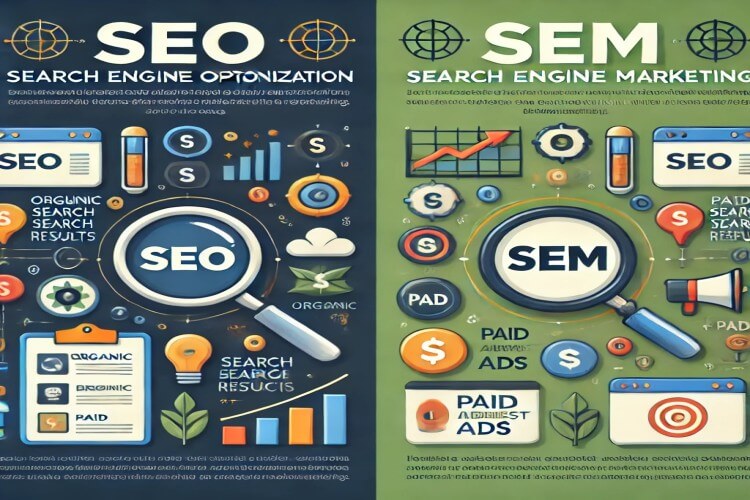What is the Difference Between SEO and SEM?

In the ever-evolving world of digital marketing, two acronyms often take center stage: SEO (Search Engine Optimization) and SEM (Search Engine Marketing). Both are essential tools for increasing online visibility and driving traffic to your website, but they differ significantly in approach and purpose. Understanding these differences can help businesses decide which strategy aligns best with their goals. Let’s break down the key distinctions between SEO and SEM.
What is SEO?
SEO, or Search Engine Optimization, is the process of improving a website’s organic visibility on search engines like Google, Bing, and Yahoo. Organic visibility means appearing in the unpaid (or “organic”) section of search engine results pages (SERPs).
Key Components of SEO:
- On-Page SEO:
- Optimizing website content with relevant keywords.
- Crafting meta titles and descriptions.
- Improving content structure and readability.
- Technical SEO:
- Enhancing site speed and performance.
- Ensuring mobile-friendliness.
- Implementing proper URL structures and sitemaps.
- Off-Page SEO:
- Building high-quality backlinks.
- Encouraging social signals and brand mentions.
- Gaining authority through partnerships and guest blogging.
Benefits of SEO:
- Long-term results: Once established, SEO can provide consistent traffic.
- Cost-effective: No direct payment for clicks.
- Builds credibility: Organic rankings often instill more trust in users.
What is SEM?
SEM, or Search Engine Marketing, encompasses paid advertising strategies to increase visibility on search engines. The most common form of SEM is Pay-Per-Click (PPC) advertising, where businesses bid on keywords to display ads at the top of SERPs.
Key Components of SEM:
- Keyword Research and Bidding:
- Identifying high-intent keywords.
- Competing in ad auctions for these keywords.
- Ad Campaign Management:
- Creating compelling ad copy.
- Designing visually engaging display ads.
- Monitoring and optimizing campaigns for performance.
- Performance Tracking:
- Measuring impressions, clicks, and conversions.
- Analyzing cost-per-click (CPC) and return on investment (ROI).
Benefits of SEM:
- Instant visibility: Ads appear almost immediately after campaign launch.
- Targeted reach: Ads can be tailored to specific demographics and locations.
- Scalable: Campaigns can be adjusted to fit any budget.
Key Differences Between SEO and SEM
Aspect | SEO | SEM | |
Cost | Free (except for time and resources) | Paid (based on ad spend and CPC) | |
Timeline | Long-term; results take time to build | Short-term; results are immediate | |
Sustainability | Sustainable; continues driving traffic after investment | Stops when ad spend ceases | |
Positioning | Organic search results | Paid ad placements at the top or bottom | |
Click Behavior | Users trust organic listings more | Users are drawn to prominently placed ads |
When to Use SEO or SEM
Choose SEO if:
- You’re looking for long-term growth.
- You have a limited budget for advertising.
- Building brand authority and trust is a priority.
Choose SEM if:
- You need immediate visibility and traffic.
- You’re running time-sensitive promotions or events.
- You want to test and target specific audiences quickly.
Conclusion
While SEO and SEM share the common goal of driving traffic to your website, their methodologies and applications differ significantly. SEO is a long-term strategy focused on organic growth, while SEM offers rapid results through paid advertising. The right choice depends on your business objectives, budget, and timeline.
For maximum effectiveness, many businesses find that a combination of both SEO and SEM delivers the best results. By leveraging the strengths of each, you can create a comprehensive strategy that enhances both short-term and long-term success.
Are you ready to improve your online visibility? Explore how SEO and SEM can work together to elevate your digital marketing strategy!